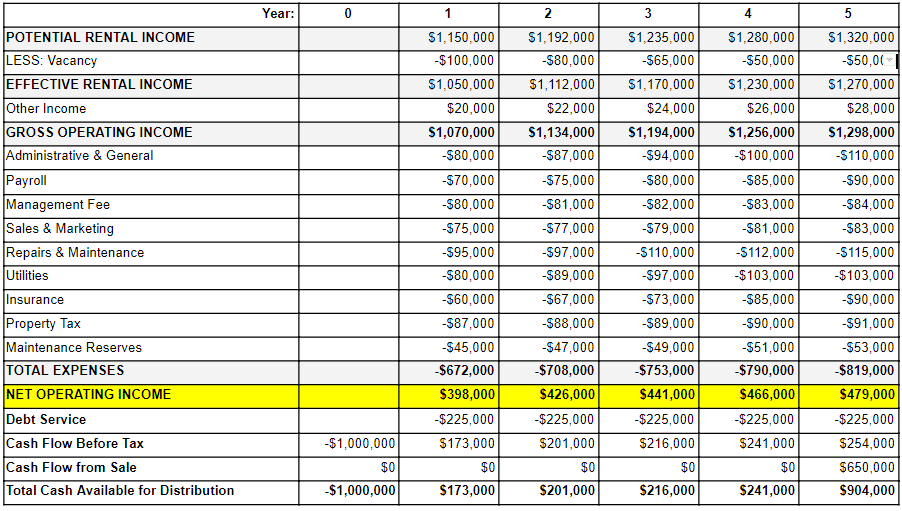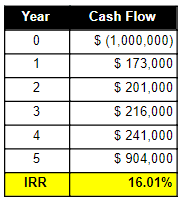When evaluating a potential property purchase, the number one question on every real estate investor’s mind is “if I buy this property, what is my potential return on investment?” There are many ways to measure this, each with its own advantages and disadvantages, and these important metrics are the subject of this article.
In order to understand what the metrics are and how they are calculated, it is first important to understand how a proforma is created.
What is a Proforma
As a precursor to calculating the return metrics, it is first necessary to create a proforma for the property. A proforma is a financial projection of the property’s income, operating expenses, and loan payments.
The property’s income is based on the amount of rental income that is expected to be received from tenant rent payments and other ancillary sources like late fees and application fees. When estimating income over a multi-year holding period, certain assumptions must be made about lease renewal rates, and the annual growth of lease payments.
A property’s operating expenses represent the costs associated with running the property on a day to day basis. These include things like property taxes, insurance, property management, legal fees, utilities, and repairs. Gross income less total operating expenses results in the calculation of a metric called Net Operating Income.
Debt service/the required mortgage payments are calculated based on the loan amount, interest rate, and amortization period. They are subtracted from Net Operating Income to arrive at another metric known as Cash Available for Distribution. This metric is also a key input into many of the return calculations. When complete, a proforma may look something like the table below:

With the proforma complete and the cash flows identified, the return metrics can be calculated.
Metric #1: Internal Rate of Return (IRR)
A property’s Internal Rate of Return or IRR is the rate of return on each dollar invested for each period of time that it is invested in. It is often advertised by fund managers and transaction sponsors as an indication of the potential return that an individual can earn on their investment.
The formula used to calculate the IRR is complex, but it is made easy by using the “IRR” function in Microsoft Excel or other spreadsheet program. To demonstrate how IRR is calculated, the cash flows from the proforma above can be rearranged into the following table:

When these cash flows are used in the IRR function, the result is 16.01%. Whether this is “good” or not depends on each individual investor’s return requirements and the risk associated with the transaction.
The benefit of using IRR as a return metric is that it accounts for the time value of money, which is the concept that a dollar today is worth more than a dollar in the future due to its ability to be reinvested over time. The major drawback of using IRR is that it doesn’t give a good idea of the investment’s absolute return. For this purpose, the Equity Multiple is the better option.
Metric #2: Equity Multiple
The Equity Multiple is the ratio of the total cash received from an investment to the cash put into it. The formula used to calculate Equity Multiple is:

Using the same set of cash flows from the proforma, the sum for all five years is $1,735,000 and the initial investment is $1,000,000. As such, the equity multiple is calculated as 1.73X ($1,735,000 / $1,000,000). This is a decent equity multiple as it suggests that the investor is going to receive one dollar and 73 cents for every dollar invested over a five year time period. Most commercial real estate investments aim for an equity multiple in the range of 2.0X – 2.5X or higher.
The benefit of the Equity Multiple is that it does provide an investor with an indication of the absolute return on an investment. But it doesn’t give any indication of how long it took to earn it. An equity multiple of 2.0X could be earned in 5 years or 50 years and it would still be the same.
Metric #3: Cash on Cash Return
Whereas the Internal Rate of Return and Equity Multiple both look at the entirety of the investment period, cash on cash return looks at each year individually. It is a measure of the cash earned on the initial investment each year. The formula used to calculate it is:

Using the same proforma cash flows above, it can be seen that the initial cash investment is $1,000,000, which is expressed as a negative number because it represents an outflow. In the first year of the proforma, the investors are projected to receive $173,000, which represents a 17.30% ($173,000 / $1,000,000) return on the initial investment in the first year of the investment holding period.
Cash on Cash return is helpful because it provides an indication of what an investor could earn in any one year. But, it ignores the impact of taxes and the initial investment does not always represent the true acquisition cost. It may not include things like broker commissions and loan fees, which can be material.
Metric #4: Gross Rent Multiplier
The Gross Rent Multiplier is a ratio of a property’s purchase price to its estimated Gross Rental Income in the first year of the investment. The formula used to calculate it is:

Gross Rent Multiplier is used as a way to quickly compare the prices of different investment property options. In the proforma example the Gross Potential Rental Income in year 1 is $1,150,000. For the sake of the example, assume that the purchase price is $8,000,000. This would equate to a GRM of 6.95 ($8,000,000 / $1,150,000).
On its own, a GRM of 6.95 this doesn’t mean much, but it can be very useful when comparing the prices of similar rental properties in the same market. There is no “good” GRM. Instead it is all relative to the investor’s individual objectives and the other properties in the market. However, it can be generally said that a smaller GRM may represent a better investment opportunity.
There are several drawbacks to using the GRM. First, it does not account for operating expenses. A property’s return isn’t based on gross income, it is based on net cash flow. In addition, it does not account for a property’s vacancy rate. For these reasons, the GRM should only be used as a starting point for comparison not as the metric used to make a real estate investment decision.
Metric #5: Capitalization Rate (Cap Rate)
Finally, a property’s capitalization rate or just cap rate, is a measure of the property’s annual return assuming an all cash purchase. The formula used to calculate it is:

In year 1 of the proforma above, the property produces Net Operating Income of $398,000. Again, assume that the purchase price of the property is $8,000,000. This would imply an “entry” cap rate of 4.98%. This means that an investor who paid $8,000,000 in cash for this property could expect to earn an annual return of 4.98%.
The cap rate is useful as a way to compare the price of one property to the price of another. It is also the market’s indication of risk. A property with a low cap rate is one whose cash flows are more stable and dependable. Typically these include well located multifamily assets or single occupant properties with a credit tenant, like a Walgreens. A property with a higher cap rate likely carries more risk because an investor has to be compensated for it. On the other end of the spectrum, these could include distressed assets or a traditionally risky asset class like a hotel or restaurant.
The downside to using the cap rate in real estate is that it only looks at a property’s Net Operating Income (NOI) in year 1, not the entirety of the investment holding period.
Final Thoughts
It is the intent of this article to show that every real estate investing return metric comes with its own set of benefits and drawbacks. For this reason, they shouldn’t be looked at in isolation. Instead, they should be looked at in aggregate, which will paint a fuller picture of the investment opportunity and provide valuable insight into the buy/don’t buy decision.
Interested In Learning More?
First National Realty Partners is one of the country’s leading private equity commercial real estate investment firms. With an intentional focus on finding world-class, multi-tenanted assets well below intrinsic value, we seek to create superior long-term, risk-adjusted returns for our investors while creating strong economic assets for the communities we invest in.
To learn more about our investment opportunities, contact us at (800) 605-4966 or ir@fnrpusa.com for more information.


